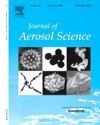The collision kernel of nanoparticles in homogeneous isotropic turbulence: Direct simulations and modelling
IF 2.9
3区 环境科学与生态学
Q2 ENGINEERING, CHEMICAL
引用次数: 0
Abstract
An accurate model for the collision kernel is essential to predict the growth dynamics of agglomerates in both, natural and industrial processes. In many cases, including the gas-phase synthesis of functional nanoparticles in flames, the model development is hampered by the coupled effects of turbulent shear and Brownian diffusion on the relative particle motion. In the present work, we perform detailed numerical simulations of spherical Brownian particles in homogeneous isotropic turbulence where their individual trajectories are directly resolved. In this way, particle pair statistics such as relative velocities, clustering profiles and, most importantly, the geometric collision rate are deduced for mono- and bidisperse systems.
Our results show that Brownian diffusion inhibits particle clustering by distributing particles more uniformly, resulting in an effective reduction of the radial distribution function. This behaviour is also observed in bidisperse particle populations where the reduction is shown to be controlled by the harmonic mean of both Peclet numbers. In addition, mean radial relative velocities are significantly enhanced when Brownian motion is considered and this increase is most evident at low Stokes and Peclet numbers. We further develop a semi-empirical model to predict the binary collision kernel by fitting suitable expressions to the simulation data. Lastly, an a posteriori analysis is carried out to demonstrate the model’s accuracy by comparing the results of the population balance calculations against independent simulations of coalescing particles. Using the present model, the error in the predicted particle number density could be reduced to around 23% while existing models from the literature deviate from the detailed simulation by a factor of 2.1 and more.
均匀各向同性湍流中纳米颗粒的碰撞核:直接模拟和建模
一个精确的碰撞核模型对于预测自然和工业过程中团聚体的生长动力学至关重要。在许多情况下,包括火焰中功能纳米颗粒的气相合成,模型的发展受到湍流剪切和布朗扩散对相对粒子运动的耦合影响。在目前的工作中,我们对均匀各向同性湍流中的球形布朗粒子进行了详细的数值模拟,其中它们的单个轨迹是直接分解的。通过这种方法,可以推导出单分散和双分散系统的粒子对统计数据,如相对速度、聚类分布以及最重要的几何碰撞率。我们的研究结果表明,布朗扩散通过更均匀地分布粒子来抑制粒子聚集,从而有效地减小了径向分布函数。这种行为在双分散粒子群中也可以观察到,其中的减少是由两个佩莱特数的调和平均值控制的。此外,当考虑布朗运动时,平均径向相对速度显著增加,这种增加在低Stokes和Peclet数时最为明显。我们进一步发展了一个半经验模型,通过拟合合适的表达式来预测二元碰撞核。最后,进行了后验分析,通过将种群平衡计算结果与聚结粒子的独立模拟结果进行比较,来证明模型的准确性。使用本模型,预测粒子数密度的误差可降至23%左右,而现有文献模型与详细模拟的偏差可达2.1倍以上。
本文章由计算机程序翻译,如有差异,请以英文原文为准。
求助全文
约1分钟内获得全文
求助全文
来源期刊

Journal of Aerosol Science
环境科学-工程:化工
CiteScore
8.80
自引率
8.90%
发文量
127
审稿时长
35 days
期刊介绍:
Founded in 1970, the Journal of Aerosol Science considers itself the prime vehicle for the publication of original work as well as reviews related to fundamental and applied aerosol research, as well as aerosol instrumentation. Its content is directed at scientists working in engineering disciplines, as well as physics, chemistry, and environmental sciences.
The editors welcome submissions of papers describing recent experimental, numerical, and theoretical research related to the following topics:
1. Fundamental Aerosol Science.
2. Applied Aerosol Science.
3. Instrumentation & Measurement Methods.
 求助内容:
求助内容: 应助结果提醒方式:
应助结果提醒方式:


